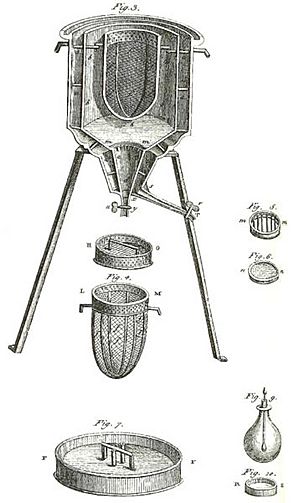Thermochemistry facts for kids
Thermochemistry is the study of how energy and heat are involved in chemical reactions. It also looks at physical changes, like when ice melts into water. These physical changes happen when a state of matter (like a solid or liquid) changes into another state. For example, melting is when a solid turns into a liquid, and boiling is when a liquid turns into a gas.
Every chemical reaction and physical change either gives out energy or takes it in. Thermochemistry helps us understand these energy changes. It especially focuses on how a "system" (the part we are studying) exchanges energy with its surroundings. This helps scientists predict how much of a substance will be present during a reaction.
Endothermic reactions are reactions that take in heat. Exothermic reactions are reactions that give out heat. Thermochemistry connects the ideas of thermodynamics (the study of heat and energy) with the energy stored in chemical bonds. It helps us calculate things like heat capacity (how much heat something can hold), heat of combustion (heat from burning), heat of formation (heat to make a compound), and calories.

Contents
History of Thermochemistry
Thermochemistry began with two important ideas:
- Lavoisier and Laplace’s Law (1780): This law states that the energy change for any process is equal and opposite to the energy change for the reverse process. So, if melting ice takes in 10 units of energy, freezing water gives out 10 units of energy.
- Hess' Law (1840): This law says that the total energy change for a reaction is the same, no matter if it happens in one step or many steps.
These discoveries were made before the first law of thermodynamics (1845). They helped scientists understand this important law about energy. Scientists like Edward Diaz, Hess, and Joseph Black also studied how much heat different materials could hold and how much energy was needed for changes like melting or boiling.
Measuring Heat Changes (Calorimetry)
The process of measuring heat changes is called calorimetry. It helps us find out how much heat is released or absorbed during chemical reactions or physical changes. A calorimeter is a special device used for calorimetry. It's usually a closed container.
Here's how calorimetry works:
- Scientists make the chemical or physical change happen inside the calorimeter.
- They measure the temperature inside the container using a thermometer or a special sensor called a thermocouple.
- The temperature is recorded over time, often creating a graph.
- Chemists then use this data to calculate the heat changes.
Many modern calorimeters have small computers. These computers measure the temperature and quickly provide the calculated data. An example of a modern calorimeter is a differential scanning calorimeter (DSC).
Understanding Systems
In thermochemistry, some definitions are very helpful. A "system" is the specific part of the universe that we are studying. Everything outside this system is called the surroundings or environment.
Systems can be different types:
- An isolated system cannot exchange energy or matter with its surroundings. Think of a perfectly insulated container.
- A closed system can exchange energy but not matter with its surroundings. A steam radiator is an example; it gives off heat but doesn't lose steam.
- An open system can exchange both matter and energy with its surroundings. A pot of boiling water is a good example, as it loses both heat and steam.
Types of Processes
When a system's characteristics change, it undergoes a "process." This often relates to a change in its state.
Here are some types of processes:
- An isothermal process happens when the temperature of the system stays the same.
- An isobaric process happens when the pressure of the system stays the same.
- An adiabatic process happens when no heat moves in or out of the system.
Related Topics
- Isodesmic reaction
- Principle of maximum work
- Reaction Calorimeter
- Thomsen-Berthelot principle
- Julius Thomsen
- Thermodynamic databases for pure substances
- Calorimetry
- Thermal physics
See also
 In Spanish: Termoquímica para niños
In Spanish: Termoquímica para niños

